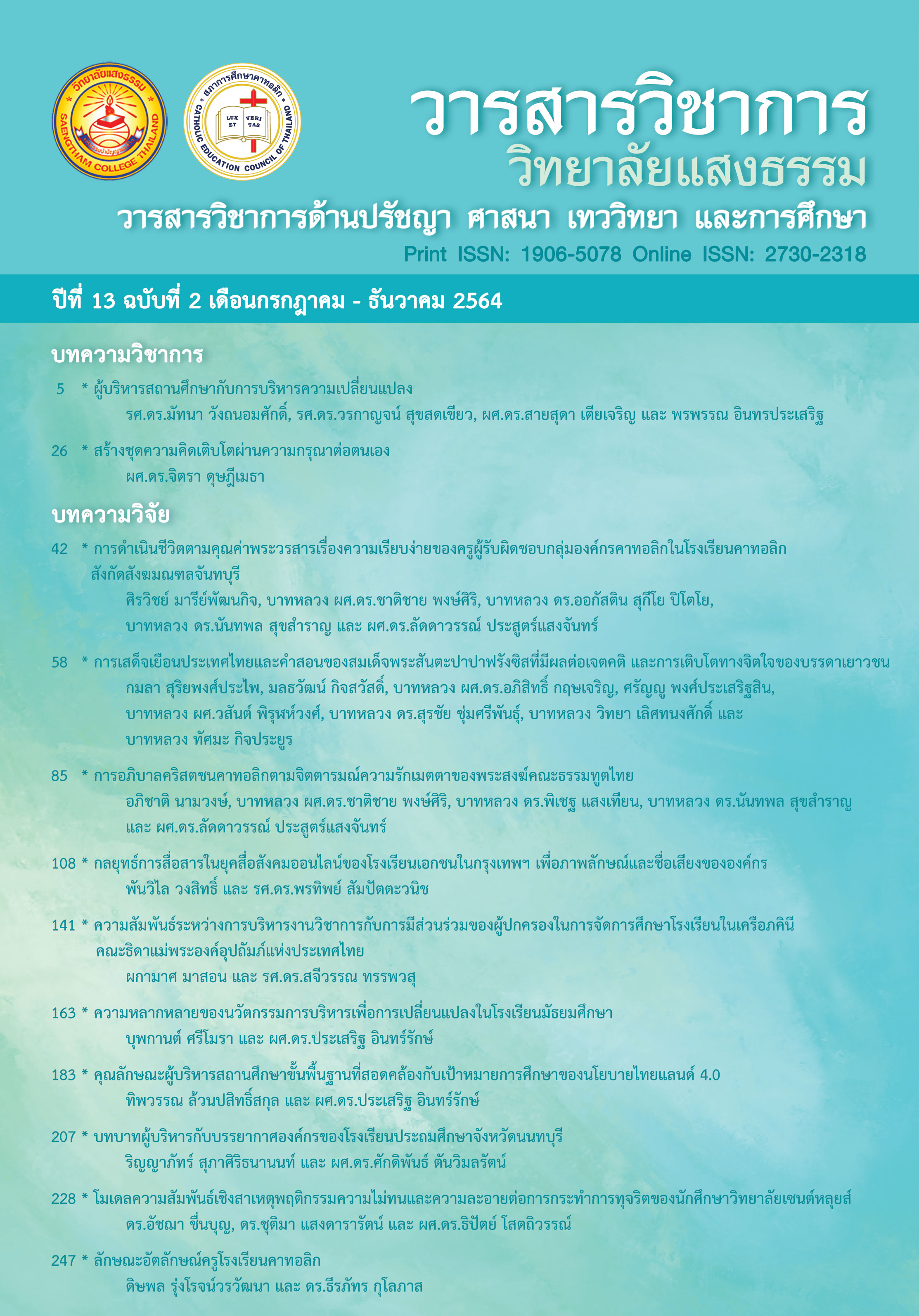A Causal Relationship Model of Intolerance and Shame for Corruption of Students in Saint Louis College.
Main Article Content
Abstract
The purposes of this research were aimed to develop and validate a causal relationship model of intolerance and shame for corruption of students in Saint Louis College. The sample involved 387 undergraduates of Saint Louis College in academic year 2017. The research instrument was Likert-type opinions, consisting of five variables: attitude toward the behavior, subjective norm, perceived behavioral control, behavioral intention, and intolerance and shame for corruption. Data were collected from May to June 2018. Structural equation modeling is involved in the use of AMOS. The results indicated that behavioral intention was a direct cause of intolerance and shame for corruption. Meanwhile, attitude toward the behavior, subjective norm, and perceived behavioral control indirectly affected intolerance and shame for corruption. The proposed model was consistent with empirical data. Goodness of fit statistics were: chi-square test=3.578, df=2, relative χ2=1.789, GFI= .996, AGFI=.972, RMR=.005, and RMSEA=.045
Article Details
- The academic and research articles, as well as the content and opinions expressed therein, published in Saengtham College Journal are solely the responsibility of the respective author(s).
- Articles published in Saengtham College Journal are the property of Saengtham College. Reproduction, modification, or dissemination of all or part of the content in any form without written permission from Saengtham College is prohibited.
- Articles published in Saengtham College Journal are protected under the Copyright Act.
References
พูลพงศ์ สุขสว่าง. (2557). หลักการวิเคราะห์โมเดลสมการโครงสร้าง. วารสารมหาวิทยาลัยนราธิวาสราชนครินทร์, 6(2), 136–145.
พวงเพชร ศิริโอด. (2558). ปัจจัยด้านความตั้งใจซื้อที่มีผลต่อพฤติกรรมการซื้อสินค้ามือสองของผู้บริโภคในตลาดนัด. ปริญญามหาบัณฑิต, มหาวิทยาลัยเทคโนโลยีสุรนารี.
พริม สุกแสงฉาย. (2560). การโกงข้อสอบ : เมื่อค่านิยมสำคัญกว่าความถูกต้อง. [ออนไลน์]. เข้าถึงได้จาก : http://www.anticorruption.in.th/2016/th/detail/632/4/. สืบค้นเมื่อ 30 เมษายน 2561.
พัชรี ดวงจันทร์. (2550). ปัจจัยเชิงสาเหตุของพฤติกรรมการป้องกันโรคอ้วน และดัชนีมวลภายในเด็กนักเรียนชั้นประถมศึกษาปีที่ 4 โรงเรียนสาธิต กรุงเทพมหานคร. วิทยาศาสตรดุษฎีบัณฑิต, มหาวิทยาลัยศรีนครินทรวิโรฒ.
พิชญ์ณิฐา พรรณศิลป์, ภักดี โพธิ์สิงห์ และสัญญา เคณาภูมิ. (2559). การคอรัปชั่นในระบบราชการไทย: แนวทางการป้องกันและแก้ไข. วารสารสันติศึกษาปริทรรศน์ มจร, 4(2), 326–340.
วิชา อมระดิษฐ. (2560). สาเหตุของปัญหาคอร์รัปชั่นและแนวทางการแก้ปัญหาในหน่วยงานภาครัฐ. เอกสารการวิจัยส่วนบุคคล. วิทยาลัยการทัพบก.
วิวัฒน์ จันทร์กิ่งทอง. (2557). ทฤษฎีพฤติกรรมตามแผนกับความภักดีของนักท่องเที่ยว. วารสารมหาวิทยาลัยศิลปากร ฉบับภาษาไทย, 34(2), 131-146.
เสน่ห์ พลีจันทร์, พูลพงศ์ สุขสว่าง และสุพิมพ์ ศรีพันธ์วรสกุล. (2555). โมเดลความสัมพันธ์เชิงสาเหตุของพฤติกรรมการป้องกันโรคอุจาระร่วงรุนแรงจากเชื้ออีโคไล โดยมีการรับรู้ความสามารถในการควบคุมตนเองเป็นตัวแปรกำกับ. วิทยาการวิจัยและวิทยาการปัญญา, 10(2), 35-44.
อัชฌา ชื่นบุญ, ชุติมา แสงดารารัตน์ และชญารัตน์ บุญพุฒิกร.(2561). การเปรียบเทียบพฤติกรรมความไม่ทนและความละอายต่อการกระทำการทุจริตของนักศึกษาวิทยาลัยเซนต์หลุยกับนักศึกษามหาวิทยาลัยเทคโนโลยีราชมงคลสุวรรณภูมิ. วารสารสุขภาพกับการจัดการสุขภาพ, 4(1-2), 76–85.
Bentler, P. M., & Chou, C. P. (1987). Practical issues in structural modeling. Sociological Methods & Research, 16(1), 78-117.


